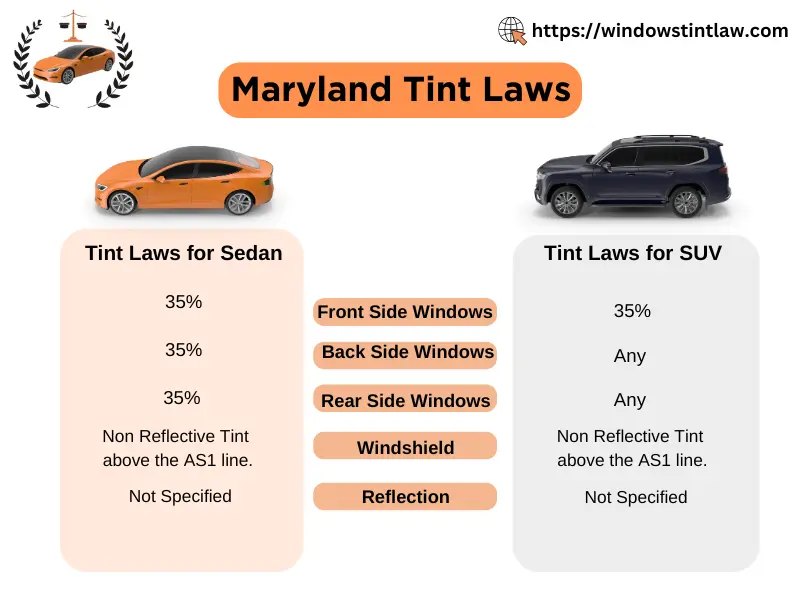Maryland tint laws were legislated in 1995 which require motor vehicles with tinted windows must pass 35% Visible light transmitted through their windows.
Visible Light Transmission percentage is an important factor to consider while tinting your Car windows. Check out the detailed guidelines about the legal limits of Tint darkness, Tint reflection and Prohibited Tint Colors.
Overview of Maryland Tint Laws
The below image summarize the window tint darkness and tint reflection requirements for Sedan and SUV type motor vehicles. Vehicle Owners and passenger can enjoy advantage of windows tinting but follow the tint limits to comply with the State laws.

Darkest Legal Tint in Maryland
Drivers and Vehicle owner in Maryland should follow the below mentioned Windows Tint Darkness and Tint Reflection limits. By following the legal limits, you can avoid penalties and legal actions from the state departments.
Tint Darkness For Sedan
| State | Front Side Windows | Back Side Windows | Rear Window | Windshield | Tint Reflection | Color Tints |
| Maryland | 35% | 35% | 35% | Non reflective tint above the AS1 line or 5 inches from Top. | Not Specified | Red, Yellow and Amber Tint colors are not allowed. |
Tint Darkness For SUV or Vans
| State | Front Side Windows | Back Side Windows | Rear Window | Windshield | Tint Reflection | Color Tints |
| Maryland | 35% | Any | Any | Non reflective tint above the AS1 line or 5 inches from Top. | Not Specified | Red, Yellow and Amber Tint colors are not allowed. |
Window Tint Reflection
Maryland code for Transportation has not specified the legal requirements for the Motor Vehicle Window Tint Reflection.
Although, The safe limit for tint reflection is, Tinted material installed on windows must not reflect light to a greater extent than a standard window without any tinting material installed. Identify the best type of tint which must not reflect light to large extent.
If you want more specific details about the Window tint reflection laws in Maryland, We recommend you to consult with the concerned department.
Other Rules and Regulations
Motor vehicles registered in Maryland need to follow these rules too:
- Dual Side mirrors are required if the rear window is tinted.
- Red, Yellow and Amber Tint colors are not allowed by the state laws.
- Sticker to show the legal tint is not required to display on Vehicle’s windows glass.
- Manufacturers need to certify that they are selling legal tinting materials as per state laws.
Medical Exemption
Maryland Tinting laws allow medical exemption for individual who require protection from the Sun. A written certification in proper format is required to show, if vehicle is stopped by the Police officer.
Maryland Code, Transportation § 22-406, Section 4 allows the person to get exemption from the tinting laws.
Penalties for Violating Maryland Tint Laws
If any person violate Tint laws, he will get a Safety Equipment Repair order. It means you must have to remove the illegal tint or replace it with the window film which meets the window tinting laws.
Failure to fix the illegal tint within Five business days can result in heavy fine of value $1000.
Further to above, Your vehicle will require re-inspection from Automotive Safety Equipment Division to verify the compliance with Tint laws. Non-compliance with state laws not only increases the risk but also chances of being pulled over by the concerned authorities.
